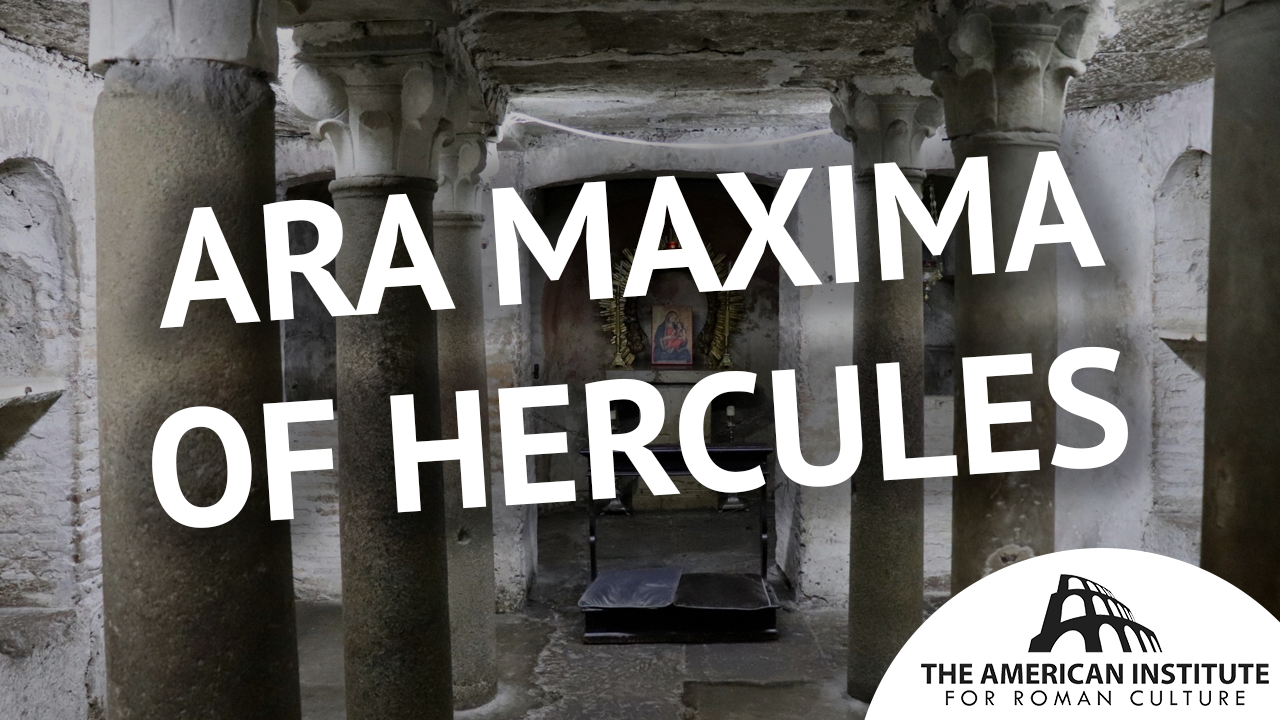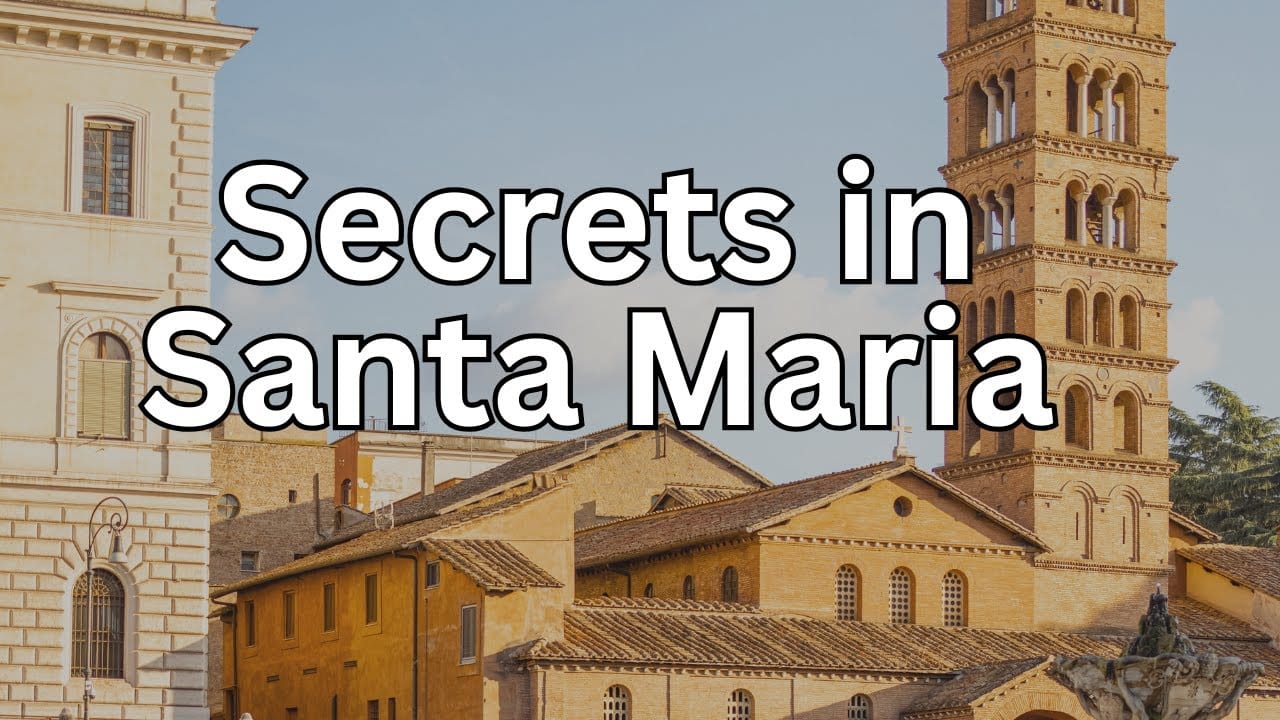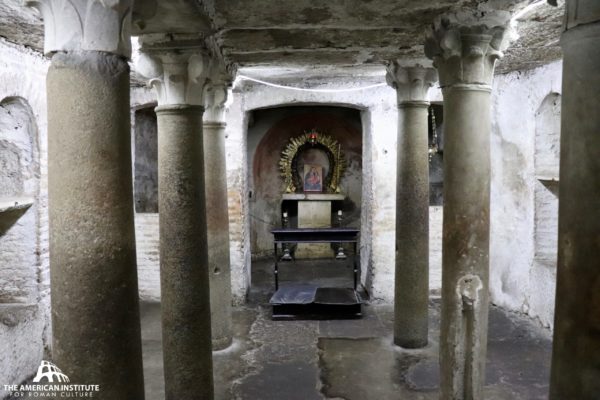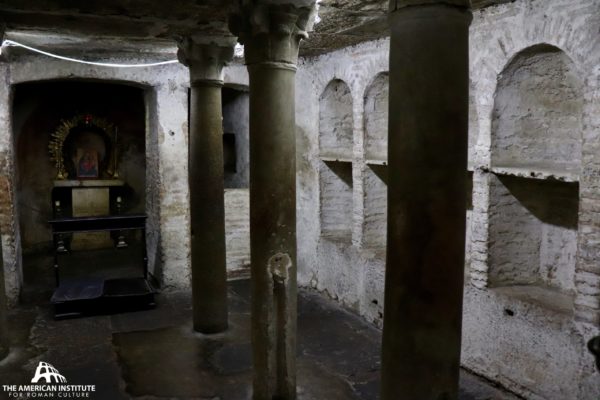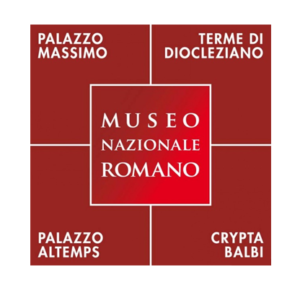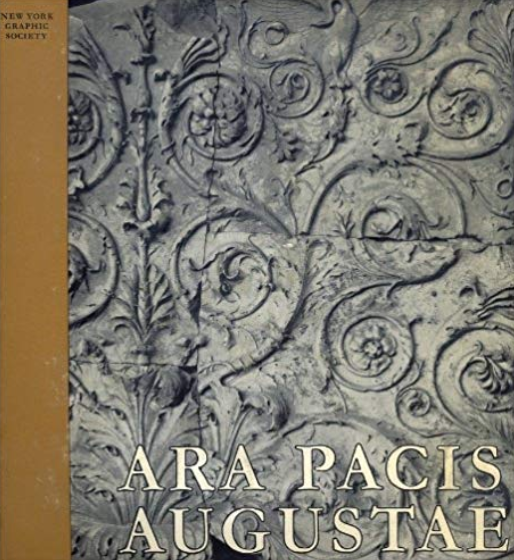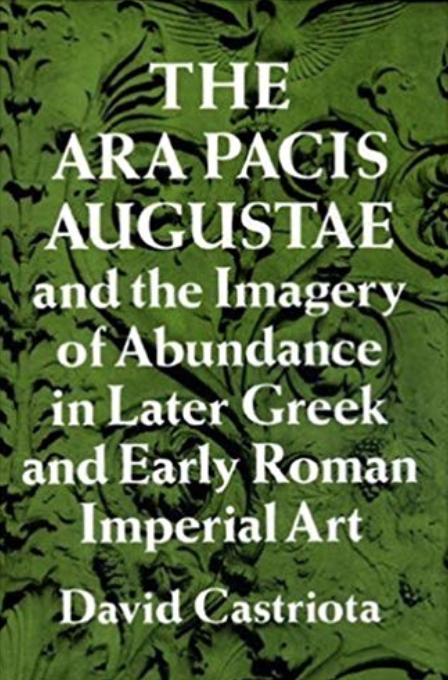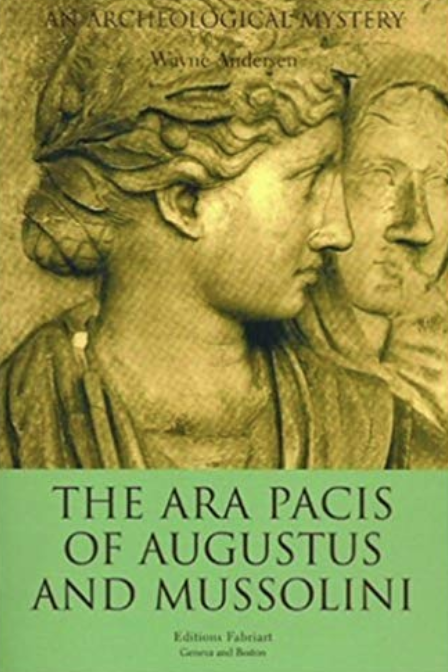This is the oldest and most venerable monuments to Hercules in Rome; the Romans credited its creation to Evander who personally thanked Hercules after he killed a local monster, Cacus, that was terrorizing his people. (Servius ad Aen. 8.269, Macrobius, Sat. 3.11.7, 12.4). It was located within the pomerium (Tacitus, Ann. 15.41), rebuilt after the Fire of Nero in AD 64. Some tuff block platform remains of an achaic/ Republican period structure under the crypt of S. Maria in Comedin have been identified as a portion of the once large-scale altar dedicated to Hercules. Some sections preserved are 3-4 meters high, on a platform that measures 20 X 31.5 meters, and it is the best candidate out of the remains unearthed.
The earliest cult-centre of Hercules in Rome, in the forum Boarium, erected, according to tradition, when Hercules had slain Cacus, and his divinity had been recognised by Evander (Liv. i. 7. IO-II; ix. 29.9; Dionys. i. 40. 6; Fest. 237; Serv. Aen. viii. 269-271).
Read more:
The dedication of this altar was ascribed by one form of tradition-probably the earliest-to Evander (Dionys. loc. cit.; cf. Macrob. iii. II. 7; 2. 4; Tac. Ann. xv. 41; Myth. Vat. ii. 153 ; Strabo v. 3.3), by another to Hercules himself (Liv. loc. cit.; Ov. Fast. i. 581; Prop. iv. 9. 67; Solin. i. 10; Verg. Aen. viii. 271 1), and by a third to the companions whom Hercules left behind in Italy (Macrob. iii. 6. 17). In the forum Boarium, its site is also described as post ianuas circi Maximi (Serv. loc. cit.), iuxta circum (Schol. Iuv. viii. 13 ; cf. Schol. Veron. Aen. viii. 104), and within the line of the Palatine pomerium at one corner (Tac. Ann. xii. 24). It stood, therefore, in the eastern part of the forum Boarium, near the carceres of the circus, and probably very near to the temple of HERCULES VICTOR (q.v.), that is, at the north-east corner of the Piazza di Bocca della Verita, north of S. Maria in Cosmedin (LS iii. 41-42; DAP 2. vi. 274).
This altar was burned in the fire of Nero (Tac. Ann. xv. 41), but was restored, and was standing in the fourth century (Fest. Serv. locc. citt.). To the second, third, and fourth centuries belong several inscriptions, dedicated by praetors to Hercules Invictus (CIL vi. 312-315, 317-318; 316 Alcide ; 319 Hercules Victor), which were found near by when the ruins of the round temple, identified with that of HERCULES VICTOR (q.v.), were destroyed during the pontificate of Sixtus IV, and it is not certain whether these inscriptions belonged to the temple or ara, or both. No traces of the altar itself have ever been found (cf. an unsuccessful attempt to identify it with the early structure under S. Maria in Cosmedin, M61. 1909, 107-117 2). By Tacitus and Juvenal (loc. cit.) the altar is called magna instead of maxima.
It would be natural to enclose the altar, and some kind of a sacred precinct may be indicated by certain passages in literature rather than the aedes Herculis Invicti (Strabo v. 3. 3: τέμενος ; Solin. i. 10: consaeptum sacellum; Plut. q. Rom. 90: ἐντὸς τῶν περιβόλων). A statue of Hercules triumphalis (Rosch. i. 2911) in the forum Boarium, ascribed by tradition to Evander (Plin. NH xxxiv. 33) and probably referred to by Macrobius (iii. 6. I 7) and Servius (Aen. iii. 407; viii. 288 3), may have been in this ancient precinct of the ara rather than in the temple (Jord. i. 2. 481 ; Ann. d. Inst. 1854, 28-38; Arch. Zeit. 1877, 107 ff.; Gilb. i. 78-82; RE viii. 552-554; Rosch. i. 2901-29o3, 2904-2920 passim ; Wissowa, Ges. Abhandl. 260; WR 273-284). An inscription recently acquired by the Lateran Museum mentions an aedes dedicated to Hercules Invictus Esychianus (cf. CIL vi. 280, 322; BPW 1889, 683). Its provenance is unknown, but Hiilsen conjectures that it belonged to a chapel situated in the vicinity of the forum Boarium, in which the cult of Hercules was centred (RPA i. 89-94, and esp. 93, n. 10; cf. NS 1924, 67. For a Pompeian painting believed to represent Hercules at the ara Maxima see Mem. Ace. Napoli 1911, 169-180). Like the first of the two inscriptions cited, it was dedicated to Hercules by Hierus and Asylus (cf. Mart. ix. 103), slaves of Tiberius Claudius Livianus, praefectus praetorio under Trajan (Pros. i. 384, 753; cf. CIL vi. 1604; xv. 932, 2317, 7882). The name Esychianus is explained by the fact that the second inscription is a dedication (also to Hercules) by one M. Claudius Hesychus, probably a freedman of Livianus.
Explore further:
This content is brought to you by The American Institute for Roman Culture, a 501(C)3 US Non-Profit Organization.
Please support our mission to aid learning and understanding of ancient Rome through free-to-access content by donating today.
Cite This Page
Cite this page as: Darius Arya, The American Institute for Roman Culture, “Herculis, Invictii, Ara Maxima (Ara Maxima, Santa Maria in Cosmedin)” Ancient Rome Live. Last modified 06/30/2020. https://ancientromelive.org/herculis-invictii-ara-maxima-ara-maxima-santa-maria-in-cosmedin/
License
Created by The American Institute of Roman Culture, published on 10/24/2019 under the following license: Creative Commons: Attribution-NonCommercial-ShareAlike. This license lets others remix, tweak, and build upon this content non-commercially, as long as they credit the author and license their new creations under the identical terms. Please note that content linked from this page may have different licensing terms.
This content is brought to you by The American Institute for Roman Culture, a 501(C)3 US Non-Profit Organization.
Please support our mission to aid learning and understanding of ancient Rome through free-to-access content by donating today.
Ara Pacis Augustae Hardcover – 1968
The Ara Pacis Augustae and the Imagery of Abundance in Later Greek and Early Roman Imperial Art Hardcover – May 26, 1995
The Ara Pacis of Augustus and Mussolini Paperback – April 1, 2003
Cite This Page
Cite this page as: Darius Arya, The American Institute for Roman Culture, “Ara Pacis Augustae” Ancient Rome Live. Last modified 10/24/2019. https://ancientromelive.org/ara-pacis-augustae/
License
Created by The American Institute of Roman Culture, published on 10/24/2019 under the following license: Creative Commons: Attribution-NonCommercial-ShareAlike. This license lets others remix, tweak, and build upon this content non-commercially, as long as they credit the author and license their new creations under the identical terms. Please note that content linked from this page may have different licensing terms.


